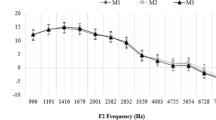Abstract
Background: The effect of stapes surgery on the recording of otoacoustic emissions is unknown. The aim of the present study was to evaluate the success of stapes surgery by using acoustically evoked otoacoustic emissions as an objective and fast method for postoperative hearing evaluation. Methods: Transient evoked (TEOAE) and distortion product otoacoustic emissions (DPOAE) were measured consecutively in otosclerosis patients before as well as 3 and 6 months after stapes surgery. Results: Air-bone gaps in the pure-tone audiograms were significantly reduced in all patients. TEOAEs and DPOAEs were not measurable preoperatively and were only evident in one patient postoperatively with low amplitudes in a narrow frequency range. Conclusions: Despite a subjective hearing improvement and a significant reduction of the conductive loss, otoacoustic emissions are only rarely evident after successful stapes surgery.
Similar content being viewed by others
Author information
Authors and Affiliations
Additional information
Received: 26 September 2000 / Accepted: 30 November 2000
Rights and permissions
About this article
Cite this article
Herzog, M., Shehata-Dieler, W. & Dieler, R. Transient evoked and distortion product otoacoustic emissions following successful stapes surgery. European Archives of Oto-Rhino-Laryngology 258, 61–66 (2001). https://doi.org/10.1007/s004050000310
Issue Date:
DOI: https://doi.org/10.1007/s004050000310



